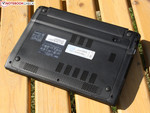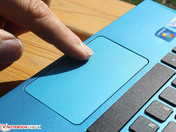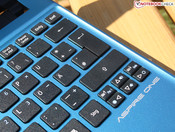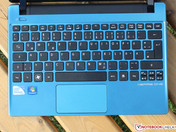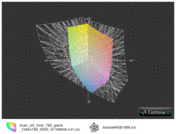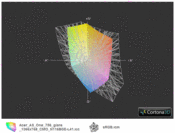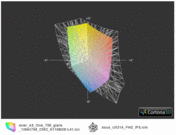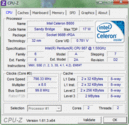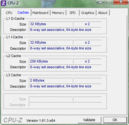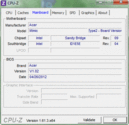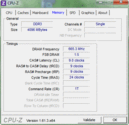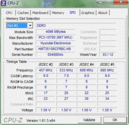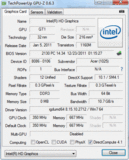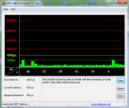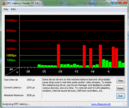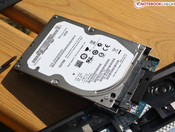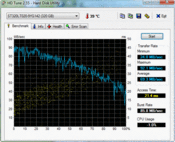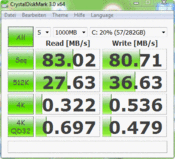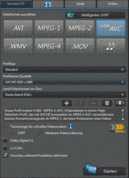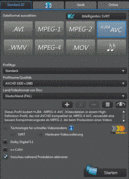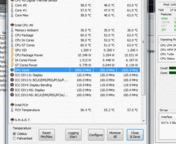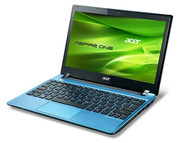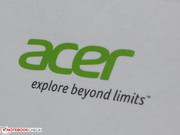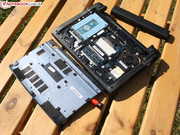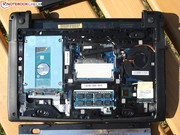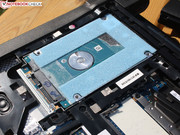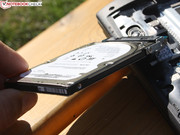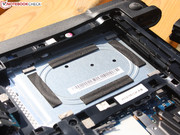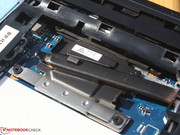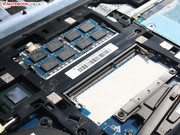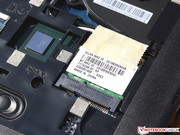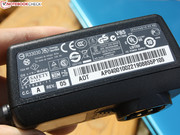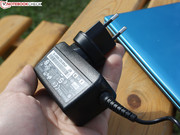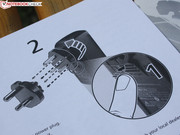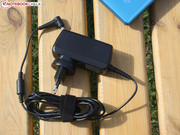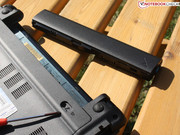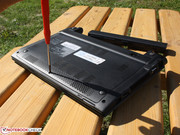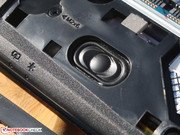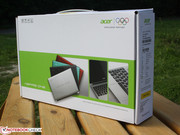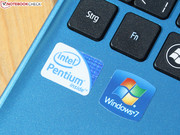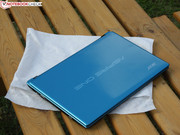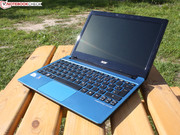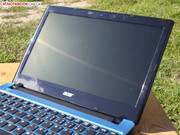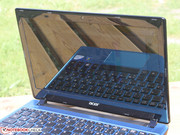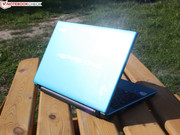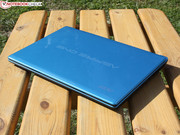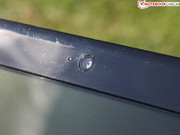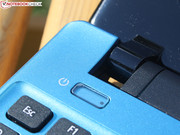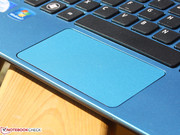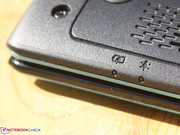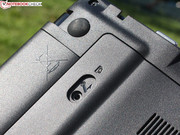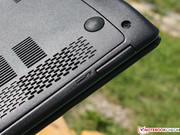Review Acer Aspire One 756 Subnotebook

The manufacturer Acer wants to offer as many devices to its customers as possible. What better way than a 11.6-inch subnotebook. The price is also reasonable with the Aspire One 756 being available from 279 Euro (~$354), but for that kind of money you get no operating system and the Celeron 877 processor. We did not want to install an OS and then search for drivers. Therefore, we chose the more expensive version of the One 756 for 399 Euro (~$506). The differences are the Pentium B987, 4 GB system memory and the 64 Bit Windows 7.
The 756 is another member of the 11.6-inch series One 7xx. We have already reviewed the Acer Aspire One 722/725 (AMD C-60). Until now there was no Intel version. The One 756 does not rival Intel's ultrabooks because its performance is too low. The 11.6-inch notebook is more an alternative to devices equipped with the AMD APU like the Asus Eee PC 1225B, R252B, HP Pavilion dm1, Lenovo IdeaPad S205 and the Lenovo ThinkPad X121e (all coming with the AMD E-450). The competitors are currently available with the APU refresh that include the E2-1800 and the E-1200. Some of the new devices are the ThinkPad Edge E135 and the IdeaPad S206 (both featuring the E2-1800). In the performance section, we will compare our test unit with the old and new AMD alternatives.
Case
Our 756 bears no relation in terms of chassis to either the One 722 or the One 725. There are some optical similarities such as the rounded corners, the hinges, and the wedge profile. But the positioning of the ports is different, as well as the input devices. The shaping of the work area and the bottom cover are different too.
Our test unit comes in glittering blue paint and is a little chameleon. While in the sun it shines bright blue (see pictures), but in the dim, office light it seems to be colored turquoise.
The slim chassis narrows toward the front and is 24 mm (0.94 inches) high (without the feet) at its thickest point. The lid is relatively thin and correspondingly flexible. The surface is, however, pressure resistant. The display hinges are firmly attached to the base unit. The visible cover is made of the same flexible plastic.
The case is fairly stable and can only be twisted slightly. Because of the tight hinges, the display lid does not wobble, but the freedom of motion is pretty limited. The palm rests on the other hand, do not give at all. The bottom cover also withstands point pressure. The keyboard is solid and the battery does not wobble. In short, the Aspire One 756 shows pretty good workmanship, but comes with an unstable base unit.
A possible cause is the large maintenance cover, which gives complete access to the interior after removing a single screw. This is very convenient for the replacement of components, but takes away the rigidity of the bottom cover.
The glossy lid, panel, and display bezel, make for surfaces which are easy to pick up a lot of fingerprints. Fortunately this is not the case with the work area. The dull plastic keys go well with the glossy surroundings. The hinges allow a wide opening angle of 170 degrees. This is very practical when the subnotebook is used in bed or in very limited space (say the bus, plane, etc.). There is sufficient strength to the joints of the keyboard and the display. When upside down, the lid opens by itself by only 2 centimetres. This is exactly the space that the second hand needs to hold the base when opening the lid.
Connectivity
The Aspire One 756 is well equipped as the Aspire One 752 subnotebook with an addition of Bluetooth 4.0 technology. In addition to the standard USB 2.0 ports, we find an HDMI and a VGA D-Sub port. The microphone jack has been cut out in favor of a combined jack. This is ideal for headsets with a multi-polar combo connector. If you want to use separate microphone and headphones, you must first get a hold of the clumsy Y-adapter.
Communication
The rest of the interfaces are the standard minimum and can also be found in a netbook. The Ethernet connector (RJ45, Gigabit LAN) is obligatory, despite the fact that most users have already forgotten that the "Internet" can be used via cable. The Atheros AR5BWB222 Wireless Network Adapter supports Draft N and also incorporates the Bluetooth 4.0 module. For transfers of large data in the home network, we recommend the RJ45 cable and a gigabit switch.
Accessories
In the box we find a small set-up pamphlet, the warranty terms, a flyer for the AC adapter, and a polishing cloth. The 1.3 MP webcam which can take photos up to a resolution of 1280x720 pixels, seems somewhat pixelated. A small status LED indicates operation. Thus the user can be sure whether or not he is being recorded. The webcam shows high noise (photos taken in daylight) and should not be used for anything more than video calls.
Maintenance
The access to the components is very simple. Remove the screw, push towards the front, and you're done. A system memory module (4 GB) is inserted and a second RAM slot is free. The HDD is held without screws in a rubber mount. The fan can be removed easily for cleaning purposes. For the battery locking mechanism, Acer uses a single recessed lock. This cannot be pushed with a finger, but with the tip of a pen.
Warranty
12 months manufacturer's warranty which is a bring-in one (sending it at your own cost) are the minimum for a notebook. For the manageable 35 Euro (~$44) this period can be extended to three years. For just under 80 Euro (~$102) the Advantage warranty option will cover the sending costs. This even includes an insurance with 100 Euro (~$127) deductible and a Germany-wide pick-up service.
Input Devices
Keyboard
We did not enjoy the keyboard at all. The feedback when typing and when gliding the hands over it is vague and undifferentiated. The reasons are the unclear tactile feedback, soft stroke, and low key drop.
The keys are not tightly spaced any more (see Aspire One 722) and have a large gap, which should provide a comfortable typing experience. Practically, there is too much space, and the finger navigation seems difficult. The reasonbeing the keys are completely flat and not concave and there is almost no clear tactile feedback. The only truly positive aspect of the keyboard is the generous layout with a clear caption.
Touchpad
The cursor movement on the desktop is precise. The touch surface is smooth and relatively large and sensitive up to the edges. The ClickPad V8.1 supports the usual multi-touch gestures (minimize, maximize, scroll, rotate). The two mouse buttons are located to the left and right at the front under the notebook lip.
Furthermore, a left click is registered even if the pad is pressed in the middle or top area. The higher up we go, the harder it is to click. The short stroke does take away some of the enjoyment from the really practical input concept. It took some getting used to, but after a short time we could click an object with one finger (press anywhere on the ClickPad and held) and move it with another. When the hidden mouse button is used, the cursor can be moved to the bottom through the sensitive surface. The handling can be adjusted to individual taste in the mouse settings. If you do not like multi-touch gestures, you can switch them off completely.
Display
The 11.6-inch (29.46 cm) display made by the Taiwanese manufacturer CMO (Typ N116BGE-L41) has a resolution of 1366x768 pixels. This HD resolution has been the standard for this form factor for many years and there are no alternatives. The 16:9 panel is not anti-glare. Acer has not given up the glossy type (see also One 722/725), despite the fact that most rivals come up with matte screens (Lenovo ThinkPad Edge E130/E135, Samsung 305U1A, ASUS Zenbook Prime UX21A-K1010V and the TravelMate B113-M). Acer's CineCrystal ensures for visually contrasting colours. The measured contrast ratio, though, is only 208:1, which is normal for this price range.
| |||||||||||||||||||||||||
Brightness Distribution: 88 %
Center on Battery: 229 cd/m²
Contrast: 208:1 (Black: 1.1 cd/m²)
43.2% AdobeRGB 1998 (Argyll 3D)
61.7% sRGB (Argyll 3D)
41.62% Display P3 (Argyll 3D)
The colour space, which we compare to the AdobeRGB, sRGB, and the premium panel of the Asus UX31A (FHD IPS, 13.3-inch), is very small. The rivals cannot offer anything better for under 1000 Euro (~$1280), be it a sub-notebook or a laptop. The colour space reproduction is only important for professional image editing. But this target group would not choose the low-performance 11.6-inch notebook, but rather a workstation.
The brightness of 217 cd/m² suffices for indoor use, but is not enough to effectively counter the daylight reflections. Even with a matte panel, a minimum of 250 cd/m² brightness is needed in order to easily read from the display. But instead, we are disturbed by reflections while we are checking our e-mails with coffee and cake. The desktop is cloaked in darkness under bright daylight which makes reading a torture.
The LED panel distributes its brightness evenly, having an average illumination of 88%. On battery power, the brightness is not diminished unless the user has specified so in the corresponding energy profiles. The Aspire One 756 does not have a light sensor for adaptive luminance adjustment.
The horizontal viewing angles are very tight. Only up to 45 degrees from the central position are the colors and structure unaltered. After that, the colors are inverted and we see the so-called ghost images. If we tilt our head back (vertically), things look even worse. Writing is readable only up to 30 degrees. But the color inversion begins at 10 degrees of deviation. When multiple people gather in front of the Aspire One 756, then the viewers at the top have the worst position. The IPS panels which offer viewing angles of almost 90 degrees to each side, show that this can be improved (e.g. Asus UX31A).
Performance

The Acer Aspire One 756 currently comes with two different CPUs. One of them is the Celeron 877 in the budget model (from 280 Euro, ~$358). The Pentium 987 (in our unit, OEM name B987) is the premium model at 350 Euro (~$447). The Pentium 987 has two cores working at 1.5 GHz. The 17 W processor is based on the Sandy Bridge architecture (2010-2011) which was replaced in 2012 by Ivy Bridge. Turbo Boost, AES, and Hyper Threading are all foreign to the entry-level Pentium. These features of the Core i3, i5, und i7 processors (depending on model) are switched off.
Still active is the integrated graphics chip named HD Graphics 2000 or just HD Graphics. Here we find the only form of Turbo, which clocks the GPU from 350 to 1000 MHz. The DDR3 1333 Dual Channel memory controller is also integrated in the processor which is standard for Sandy Bridge. 4096 MB system memory on 1 x 4 GB module by Hynix and a Seagate Momentus Thin (7 mm instead of the stabdard 9 mm) HDD with 320 GB capacity complete the laptop specifications.
Processor
We are going to compare the performance of the Pentium 987 (1.5 GHz) with the AMD E2-1800, E-450 (2x 1.65 GHz) and the E-350 (2x 1.60 GHz). We will use the Cinebench R11.5 64 Bit for single and multi-core tests.
The Pentium scored 1.13 points (100%) in the multi-core benchmark. This result is significantly ahead of the E2-1800 (55-58%) and the E-450 (49-57%). An i5 3317U from the latest ultrabooks is, on average, about 110% faster.
The single-core test results are similar to the multi-core results: 0.59 versus 0.31 (E-450, 53%) and 0.34 points (E2-1800, 58%). The 3317U from ultrabooks is at about 80%. Complete CPU and graphics performance are also available on battery power. The Cinebench tests delivered identical results (including the shading test).
System Performance
The CPU tests show that the Pentium is better than the AMD APUs. Will this be the case with application benchmarks? Here the hard drive, the system memory, and the graphics card also play a role. The result of the PCMark 7 (1452 points) is almost 50% better than the AMD E2-1800 (66-68%) and the E-450 (61-69%). C60 systems such as the Aspire One 722 are a bit slower (54%). The Intel i5-3317U ultrabooks with SSDs are 255% (Asus Zenbook Prime UX31A) and, with an HDD, up to 74% (Toshiba Satellite U840W) faster.
The older PCMark Vantage (3547 points) shows the same, the AMD E2-1800 (63-66%) and the E-450 (46-74%) being slower. The difference is a bit larger because the Vantage benchmark rewards a fast hard drive more than the PCMark 7 does. The 3317U ultrabooks with an HDD are about 65% better and, with fast SSDs, are at about 224% better(Toshiba Satellite Z930-119).
| PCMark Vantage Result | 3547 points | |
| PCMark 7 Score | 1452 points | |
Help | ||
Storage Devices
The good results in comparison to AMD's APUs are not due to the hard drive. The Seagate Momentus Thin ST320LT020-9YG142 (320 GB, 5400 rpm) is a slow model in terms of transfer rates. On the other hand, the HDD is only 7 mm high. 69 MB/s read rate (HD Tune) will make any owner of a cheap SSD laugh. The HDD scores in PCMark Vantage (3355 points) and PCMark 7(1388 points) are below average for a 5400 rpm HDD. An SSD could do wonders for the practical application speeds. But when purchasing, the user should always note the installation height of only 7 millimeters.
Graphics Card
The HD Graphics 2000 performs poorly in the relevant 3D benchmarks. We could not run DirectX 11 benchmarks, such as the 3DMark 11 (only supports DirectX 10.1). In the old, but still superb 3DMark 2006, the score was 2288 points. An HD 6320 in the E-450 APU manages only a few points more (+5%). The same goes for the HD 7340 in the E2-1800 (+ 8 - 10%). The HD Graphics 4000 is 140% better in the worst case, and 321% faster in the best case scenario.
The 3DMark Vantage resulted in 789 performance points. The E-450 APU systems are 5-16% faster. A E2-1800 device is 30 - 36% faster. The HD Graphics 4000 is again between 140% and 321% faster (i5 3317U ultrabooks).
We used a self-created 1080p video project in Power Director 8 in order to prove whether or not the processor supports acceleration. It does and it is called Intel Hardware Acceleration. The result of the comparison to the APU system of the Samsung RV515 is positive. Despite the dedicated HD 6470M, the 15.6-inch Samsung took twice as long to render the same MPEG4 H.264 FHD project.
| 3DMark 06 - 1280x1024 Standard Score AA:0x AF:0x (sort by value) | |
| Acer Aspire One 756 NU.SH0EG.007 | |
| HP 655 B6M65EA | |
| Samsung RV515-S03DE | |
| 3DMark 03 Standard | 6077 points | |
| 3DMark 05 Standard | 4585 points | |
| 3DMark 06 Standard Score | 2288 points | |
| 3DMark Vantage P Result | 789 points | |
Help | ||
Gaming Performance
Games should not be high on the priority list of the user since the performance in all of the following games was very bad. This is obvious in the comparison to the APU systems which usually provide high frame rates, as the benchmarks indicated, but the differences can be neglected when deciding on the purchase.
The Radeon HD 7340 (E2-1800) performs very well at the lowest level (+20% in Risen). An E-450 system manages +26% (Risen), but only with the help of a dedicated HD 6470M (Samsung RV515). If you want to playmodern games, you need an ultrabook with an HD 4000 (+125%, Samsung 900X4C-A04DE). Anno 2070 runs 32-47% faster on an E-450 APU, whereby the game can be played smoothly in Low Details.
In games with higher CPU requirements, the Pentium can also produce higher frame rates. Battlefield 2 runs with 21 FPS and an E-450 system is 17% slower (Medion Akoya E2312 MD97974).
| Risen - 800x600 all off/low AF:0x (sort by value) | |
| Acer Aspire One 756 NU.SH0EG.007 | |
| HP 655 B6M65EA | |
| Samsung RV515-S03DE | |
| Samsung 900X4C-A04DE | |
| low | med. | high | ultra | |
|---|---|---|---|---|
| Far Cry 2 (2008) | 27.9 | 13 | ||
| Risen (2009) | 26 | 15.5 | 7.8 | |
| Battlefield: Bad Company 2 (2010) | 21.2 | 13.5 | ||
| Deus Ex Human Revolution (2011) | 23.3 | |||
| The Elder Scrolls V: Skyrim (2011) | 14 | |||
| Anno 2070 (2011) | 18.9 | 8 |
Emissions
Noise Levels
A small and light device like the Aspire One 756 (1344 grams, 2.96 pounds), should also ideally remain silent. This applies to our test unit only in idle state, although the always running fan ensure for a base volume of 32 dB (A). This remains a constant as the fan does not turn on or off in a disturbing fashion. But when under load, the small cooling system can be really loud and producing noise of up to 40 dB (A) in the stress test and 38 dB (A) during the 3DMark 2006 (the same as gaming).
Noise level
| Idle |
| 31.9 / 32.3 / 32.4 dB(A) |
| HDD |
| 32.5 dB(A) |
| Load |
| 37.7 / 40.6 dB(A) |
 | ||
30 dB silent 40 dB(A) audible 50 dB(A) loud |
||
min: | ||
Temperature
Is the Aspire One 756 a flat radiator? This fear has unfortunately been confirmed. Even in idle state, the constantly running fan cannot drop the temperature below 32 degrees centigrade (surface). Especially the left palm rest remains considerably warm. If you surf the web, open Word files, and occasionally compress a Zip file, you will have to deal with a two degree higher average temperature.
The 11.6-inch notebook becomes very hot under constant load, in our stress test with Prime 95 and Furmark. The base reaches up to 57 degrees centigrade. This increases the average to 46 degrees centigrade, since the temperatures vary.
(-) The maximum temperature on the upper side is 46.6 °C / 116 F, compared to the average of 35.9 °C / 97 F, ranging from 21.4 to 59 °C for the class Subnotebook.
(-) The bottom heats up to a maximum of 57.5 °C / 136 F, compared to the average of 39.3 °C / 103 F
(±) In idle usage, the average temperature for the upper side is 32.5 °C / 91 F, compared to the device average of 30.8 °C / 87 F.
(-) The palmrests and touchpad can get very hot to the touch with a maximum of 42.3 °C / 108.1 F.
(-) The average temperature of the palmrest area of similar devices was 28.2 °C / 82.8 F (-14.1 °C / -25.3 F).
Speakers
Our acoustic expectations of the 11.6-inch device were not very high. And they shouldn't be since the two stereo speakers located under the palm rests, can only meet the minimum level of quality. The highs-heavy sound is painful to the ear. The highest volume can still be reached without rasping sound from the small membranes. The connection of external speakers through either the 3.5 mm jack or the HDMI output is obligatory for music fans.
Battery Life
Power Consumption
The energy consumption is between 8 W in idle and 27 W under load with 3DMark2006. Depending on the brightness, the energy profile, and the activity of the wireless modules, the idle consumption can reach 10 W. AMD can beat this with their APUs. Thus the 15.6-inch HP 655 reaches 8-12 W in idle (3DMark 26.5 W), which is better.
APU systems in 11.6-inch notebooks are sometimes more efficient than our low-voltage Pentium system: The Lenovo ThinkPad X130e (4 - 8 W) and the Sony Vaio VPC-YB3V1E/S (6.5 - 11 W). This difference is not significant since it is highly dependent on the maximum brightness of the displays.
When the 11.6-inch really needs to work (stress test), the consumption rises up to 32.5 W. Given a CPU with 17 W TDP, this leaves 15 W for the HDD, lighting, wireless modules, and chipset. The battery was fully charged for the tests. The 40 W AC adapter has enough power. Nevertheless, it heats up to 55 degrees centigrade in the stress test.
| Off / Standby | |
| Idle | |
| Load |
|
Key:
min: | |
Battery Life
The 37 Wh batter does not provide the expected run times. In idle the 11.6-inch notebook lasts 5 hours and 55 minutes. Since this is possible only with minimum brightness and inactive WLAN, it is far from realistic. The WLAN surfing test is far more practical. After 3 hours and22 minutes the battery was empty, but then it needed almost three hours in order to recharge.
This is not good. Under two hours charging time, considering the lower capacity, should be enough. The short runtime has the same cause: The battery capacity of 37 Wh is too small. With 48 Wh, the 11.6-inch notebook could have managed five hours. And the customers would have surely tolerated a battery sticking out.
In comparison, the APU subnotebooks are better, mainly because their manufacturer has equipped them with batteries with larger capacity. The 8 hours 45 minutes of the Samsung 305U1A (11.6-inch, 66 Wh) in the WLAN test now seems almost gigantic. A Lenovo ThinkPad X130e (62 Wh) is also very good with 7 hours 07 minutes. But a Sony Vaio VPC-YB3V1E/S with a lower capacity battery also manages 3 hours 55 minutes.
Due to the lack of a DVD drive, we played a low resolution AVI film, whereby the battery lasted for 3 hours 44 minutes. Under load, the runtime drops below two hours, especially under graphics load(Furmark 1 hour 30 minutes). Under CPU load (Prime95) the time was 1hour 52 minutes (identical with the Battery Eater Classic).
Verdict
Acer has ended the absolute domination of Accelerated Processing Units (APU) in the price range below 400 Euro (~$511). The statement of course exaggerates the situation since it neglects the still existing devices with Intel Atom. In fact, with the Aspire One 756, Acer brings to the market, through the integrated low-voltage Pentium, a real alternative to the APU notebooks. Unfortunately, the more powerful Pentium is only an option using the AC adapter. Acer has installed a weak battery (37 Wh). Thus the E-450/E-1800 subnotebooks remain at the top in terms of battery life.
As if this was not enough, the disadvantages continue with the flexible chassis and overall weak input devices. The high heat emission under load, the glossy and dim display, and the charging time of nearly three hours rounds everything up.
Overall the test shows that the Pentium 987 is a real alternative to the slow APUs and Atom processors in the low-cost range. Unless the potential customers care too much about the display or the battery life, a Pentium 11.6-inch notebook for 349 Euro is a better investment than an Atom N2600 or N550 for 250 to 290 Euro. Before we actually test the Celeron 877, we can only recommend the Pentium 987. Overall the notebook is not for the casual gamers who should take a look at an ultrabook with the HD Graphics 4000. APU notebooks are also a poor choice for the same target group.




